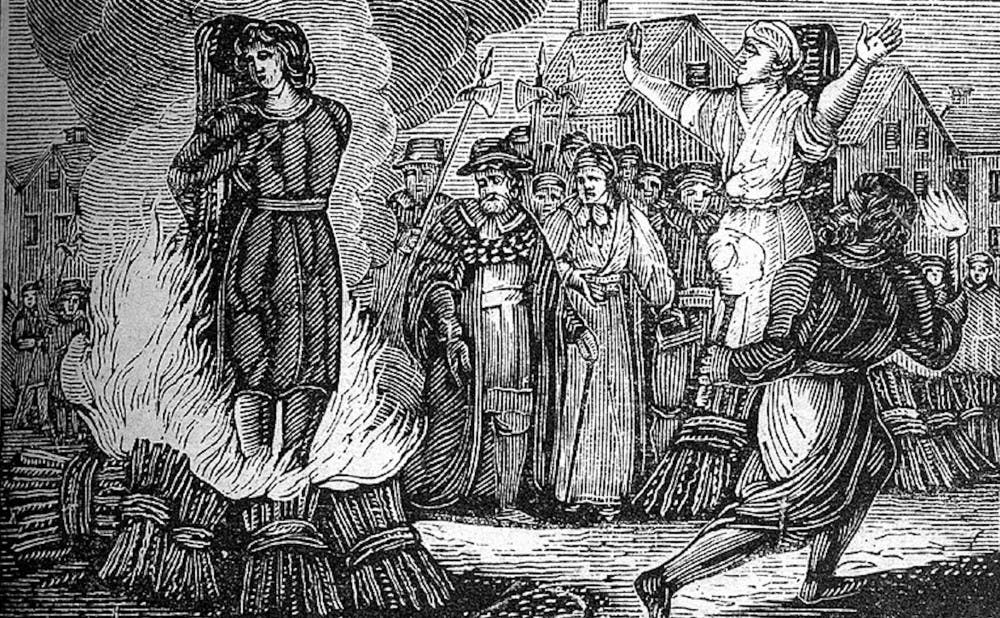The Theater Studies department is hard at work on their production of “Vinegar Tom,” a 1976 play by feminist playwright Caryl Churchill, which will open at Sheafer Lab Theater Thursday, Nov. 9, and run through Sunday, Nov. 19. Set in the late 17th century, “Vinegar Tom” is a grim tale of the peril that befalls four women who don’t subscribe to accepted standards—women slandered as witches.
“Don’t expect ‘The Crucible,’” warned Dr. Jules Odendahl-James, adjunct faculty director of the Theater Studies department and director of “Vinegar Tom.”
For Odendahl-James, the play steps beyond the outdated witch hunt tale and suggests more complexity than a battle of good versus evil.
“This [witch hunt] is a metaphor that strikes close to home for women specifically,” Odendahl-James said. “Unlike ‘The Crucible,’ the women at the core of this are not the troublemakers, but the victims. They’ve done nothing but be the wrong kind of person.”
While the show has a historical setting, its themes and and messages carry weight in modern social and political terrains.
“I hadn’t imagined the amount of ‘witch hunt’ rhetoric that would emerge since the time I chose this play,” Dr. Odendahl-James said. “But what does it mean to have that really happen?”
She hopes “Vinegar Tom” will instruct audiences on the horrific yet common set of circumstances that come about when people are “othered and persecuted for that otherness.”
Plays written by women that expose the injustices women face are central to the work of Odendahl-James, who also serves as director of academic engagement for the Humanities at the Duke Academic Advising Center and associate artistic director at Manbites Dog Theater in Durham. This season alone, she is directing three shows by female writers, featuring primarily female casts.
“Once you are attached to being seen as a woman or behaving in particularly feminine kinds of ways, there are burdens that come with that,” she said. “So I’m always looking for plays that take women’s experiences seriously.”
But beyond the disparagement and shame faced by unconventional women, “Vinegar Tom” casts a startling light on the violence such women have historically been subjected to. Horrors ranging from torture to a hanging are performed onstage, posing the difficult task of presenting violence in a way that is shockingly meaningful rather than sensationalizing.
Odendahl-James envisions a thematic rather than hyper-realistic portrayal of the show’s explicit brutality, and has hired professional fight choreographer Jeff A.R. Jones to help communicate the personal horror within the violence.
The director has also been collaborating with a number of professional designers to see her vision for the show come to fruition. Among them is lighting designer Chuck Catotti, who will enlist the help of his lighting design class in his work on the show. Likewise, AAHVS Professor Raquel Salvatella de Prada will head production design and work in concert with her class, “Animation, Comics & Theater.”
Set designer Sonya Drum is creating a unique stage setup in which time periods collide, pieces perform multiple functions and plaques commemorating the characters’ ultimate deaths give the stage a memorial air.
As a play with music, “Vinegar Tom” invites creativity; seemingly antiquated scenes are studded with songs in a range of modern genres. These unconventional additions to an otherwise period-specific plot act as a vessel for commentary, framing the show as a mirror to modern society. But in lieu of a band, the actors will step out of their character and perform the songs themselves, led by music director and arranger Bart Matthews, Trinity ‘96.
To define the role that different period settings will play in the show, Odendahl-James enlisted Trinity sophomore Meg Hancock as dramaturg. Hancock devised a cast reading list that will instruct performers’ acting choices as 17th-century townsfolk, while bringing light to the relevant issues at play in “Vinegar Tom.” Her list ranges from the writings of Emma Donoghue, author of “Room,” to Duke professor Thomas Robisheaux’s “The Last Witch of Langenburg.”
Hancock’s work also finds links between the play’s themes and issues relevant to a Duke student audience.
“The big issues in this show are about bodily autonomy and women’s rights, which are things that should be in the minds of all college students,” she said. “It also poses questions about why people are so quick to blame the minorities in society.”
For Odendahl-James, art like “Vinegar Tom” is most effective in sounding these messages when performed on a stage.
“Theatre does not happen in a vacuum,” she said. “It tells a story that you can hold at a distance, but respond to in a way that feels very visceral.”
Get The Chronicle straight to your inbox
Sign up for our weekly newsletter. Cancel at any time.

